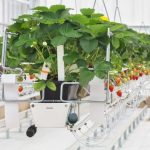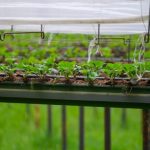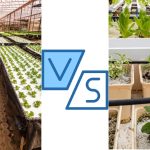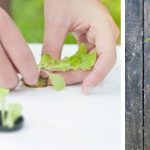Diving into the world of hydroponics, you’ve likely come across the term DWC or Deep Water Culture. This method involves growing plants with their roots submerged in nutrient-rich water, providing them with a constant supply of nutrients and oxygen. If you’ve decided to try your hand at this fascinating growing technique, getting the DWC water level right is a crucial aspect of your success.
Having the correct water level ensures your plants receive adequate nutrients without drowning the entire seedling or plant and media. It’s a delicate balance that may require some trial and error, but the results are definitely worth it.
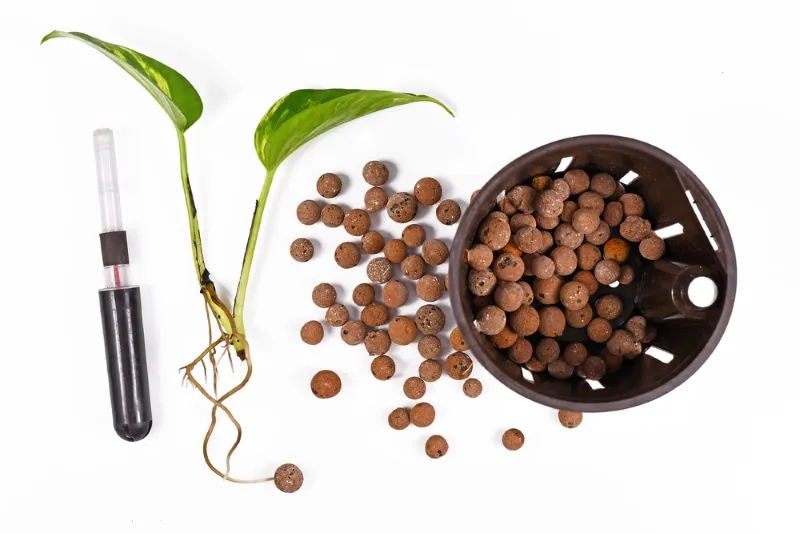
As you embark on your DWC hydroponics journey, keep in mind that the water level should be about an inch below the net pot bottom. Once your seedling roots start making their way to the water, expect rapid growth and thriving plants. Just remember to carefully monitor and adjust your water level as needed, and you’ll be well on your way to becoming a DWC hydroponics master.
Understanding DWC Water Level
From your perspective, the DWC system is relatively simple. A DWC reservoir holds the nutrient solution, while submerged air stones provide oxygen to the plant roots. Your plants will be resting in a floating or anchored net pot, with their roots reaching down into the nutrient solution.
When it comes to maintaining an ideal DWC water level, you want to ensure that only the lower part of the plant roots touches the nutrient solution. This allows them to uptake the nutrients effectively. At the same time, you should avoid submerging the entire seedling and the media. A general rule of thumb is to keep the water level about an inch below the net pot level. This will also help prevent disturbing the root zone and the emerging seedling.
It’s important to monitor and adjust the water level in your DWC reservoir regularly. As your plants grow, they will consume more water and nutrients. You’ll need to top off your reservoir to maintain the optimal water level and replenish the nutrient solution. Also, pay close attention to the pH levels, as that will affect how your plants uptake nutrients.
Related: Learn the science of deep water culture and how this hydroponic method works.
Maintaining Optimal Water Levels
DWC Water Level for Seedlings
As you start your seedlings in the DWC system, make sure the water level is close to the bottom of the net pots, so that the roots can access water easily. You can use a growing medium like Hydroton or Rockwool in the net pots to improve stability and help the seedlings’ roots reach the water.
DWC Water Level for Adult Plants
As your plants grow, you’ll need to adjust the water level to accommodate their larger root systems. In most cases, the ideal water level should be about 1-3 inches below the net pots. In a recirculating deep water culture (RDWC) system, maintaining consistent water levels between connected reservoirs is crucial for even nutrient distribution and oxygenation.
Nutrient Solution Management
Keep an eye on the nutrient solution’s pH levels, as the ideal range for most hydroponic plants is between 5.5 and 6.5. Regularly check and adjust your nutrient solution’s pH to prevent fluctuations that can harm your plants. Additionally, keep an eye on the nutrient concentration provided to the plants, allowing you to adjust them accordingly and avoid nutrient imbalances.
Temperature and Water Evaporation Control
Maintaining the ideal water temperature (between 18-20°C or 65-68°F) can prevent root rot and the growth of harmful bacteria or algae. If you’re using a DWC setup without a chiller, make sure to keep the reservoir away from direct sunlight and heat sources. Proper air circulation around your system can also help in controlling temperature and water evaporation.
Monitor and top-up the reservoir to account for water evaporation, ensuring the oxygen supply to plant roots isn’t compromised. Using a cover on the container can help minimize evaporation and reduce algae growth by limiting light exposure to the nutrient-rich solution.
How often to change DWC water: It’s recommended that you completely change the DWC water and refresh your nutrient solution every 2-3 weeks. Doing so helps prevent the buildup of harmful elements and keeps your plants healthy.
Various DWC Setups
There are a few different deep water culture system designs. Other than the traditional floating raft method, you also have the Kratky method and Bubbleponics.
Kratky Method
In the Kratky method of hydroponics, you don’t use an air pump or airstone. Your plants grow in a net pot suspended over a reservoir filled with nutrient-rich water. Since there’s no need for an air pump or airstone, it’s a low-maintenance, passive hydroponic system. As the plants grow, they drink water from the reservoir, and the water level goes down. This process creates an air gap above the water, allowing the roots to breathe. You should monitor the water level and refill it with nutrient solution when required. Use a pH meter to ensure the pH remains balanced.
Bubbleponics
Bubbleponics, also known as top-fed DWC, is a great DWC setup for beginners. In this system, an air pump and airstone are used to create bubbles, providing oxygen to the root zone. Additionally, a drip system feeds the nutrient solution directly to the plant’s roots by using a small water pump. This setup offers some advantages, such as faster growth and better oxygenation. The water level for bubbleponics should be kept high enough to keep the airstone submerged. You can maintain a consistent water level in the reservoir by topping it up with nutrient-rich water when needed. Don’t forget to check the pH regularly and adjust as required.
DWC Water Level Measurement Methods
Keeping the correct water level in your DWC hydroponic system is important for the health and growth of your plants. There are several methods you can use to measure and maintain the appropriate water level in your system, and some of these can even be set up as DIY solutions.
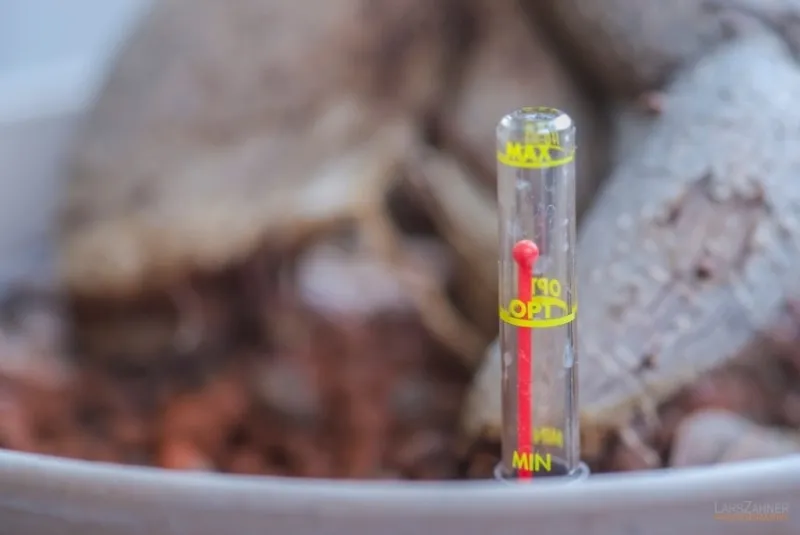
Using a DWC water level indicator: A DWC water level indicator is a simple yet effective tool that can help you monitor the water level in your system. These indicators often come in the form of a floating marker, tube, or gauge that is attached to the side of the reservoir. As the water level rises or falls, so does the marker, allowing you to easily keep an eye on the water level and make adjustments as needed.
Hydroponic water level indicator DIY: If you’re looking for a more budget-friendly solution, creating your own hydroponic water level indicator can be an interesting and fun project. One of the simplest DIY methods is to use a transparent plastic tube or piece of aquarium tubing. Attach one end of the tube to the side of your reservoir with a hole drilled just below the top. The other end of the tube should be submerged in the water. As the water level changes, the water level inside the tube will move accordingly, creating a visual indicator of the current water level in your system.
In addition to these DWC water level measurement methods, it’s essential to know the ideal water level for your specific system. Regularly topping off your water and closely monitoring the water level, whether through a DWC water level indicator or your DIY setup, will ensure the health and vitality of your plants.
Choosing and Managing the DWC Grow Medium
When selecting a grow medium for your DWC system, it’s important to consider how it will affect the water level and overall plant health. Some popular choices for hydroponic grow media include Hydroton, Rockwool, and coconut coir. These materials offer different levels of water retention, which can have an impact on the water level in your DWC setup.
Hydroton, or expanded clay pebbles, is a popular grow medium due to its lightweight nature and excellent drainage capabilities. It provides plenty of air pockets around the roots, allowing them to breathe and preventing root rot from overly saturated conditions. You’ll want to rinse and clean hydroton thoroughly before use, as the dust and debris can cloud your nutrient solution. Since hydroton does not hold water as effectively as other mediums, you may need to keep an eye on the water level and make adjustments accordingly.
Rockwool is another commonly used grow medium in DWC systems. Made from molten rock that’s spun into fibers, rockwool offers excellent water and air-holding capacities. It’s crucial to soak rockwool cubes in pH balanced water for at least a few hours or overnight before planting your seeds or cuttings, as this material has a higher initial pH. While rockwool does a great job of holding water, it can also retain too much water if not properly managed. Ensure that your water level is set appropriately and adjust as your plants grow to avoid overwatering.
Using coconut coir as a grow medium is becoming increasingly popular due to the sustainability offered by this renewable resource. This material, derived from coconut husks, has excellent water retention capabilities and provides a well-aerated environment for plant roots. However, its high water retention means you might need to adjust your DWC system’s water level to prevent over-saturation.
Regardless of the grow medium you choose, securing your plants in net pots can greatly assist in maintaining a stable and controlled water level throughout the growth process. The net pots allow roots to grow through the bottom and into the nutrient-rich aerated water. Adjust the water level in your DWC system as your plants grow, ensuring that it’s close to the seedling at first and gradually lowering it, typically to about an inch from the bottom surface of your net pot.
Growing Different Plants in DWC
Growing Vegetables
When growing vegetables in DWC, it’s important to monitor and adjust the water level regularly. For leafy greens like lettuce, maintain a shallow water level initially. This allows the roots to be partially submerged while still accessing oxygen. As your plants grow, you can gradually increase the water level.
Working with root vegetables requires care, as the water level should be high enough to support root development but low enough to avoid rot. Vegetables like tomatoes, peppers, and squash prefer a water level around half or two-thirds of the container. Pay attention to the electric conductivity (EC) levels, ensuring adequate nutrient availability for proper growth.
- Leafy Greens (Lettuce): Shallow water level
- Root Vegetables: High enough for root growth, but avoiding root rot
- Tomatoes, Peppers, Squash: 1/2 to 2/3 water level
- Monitor EC to ensure proper nutrient levels
Growing Fruits
For fruiting plants like tomatoes, peppers, or squash, start with a water level around halfway or two-thirds of the container. As these plants grow, it’s essential to maintain this water level, adjusting as needed to meet your plants’ changing needs.
Oxygenation and nutrient availability are crucial factors when growing fruits in DWC. Provide ample aeration with an air pump and airstone, and pay close attention to EC values to maintain the right nutrient levels.
- Start with 1/2 to 2/3 water level and adjust as the plant grows
- Ensure ample aeration and nutrient availability
- Monitor EC values consistently
Growing Herbs
Herbs are relatively simple to grow in DWC, but like all plants, they have specific water level preferences. For example, basil and mint prefer a shallow water level in the early stages, with gradual increases as they grow. Monitor the EC to ensure proper nutrient levels for healthy growth and strong flavor profiles.
- Shallow water level for basil and mint, increasing as they grow
- Monitor and adjust EC for proper nutrients
Troubleshooting DWC Water Level Issues
Addressing Root Rot
In a DWC hydroponic system, root rot can be a common issue due to excess water and lack of oxygen. To deal with root rot, take the following steps:
- Check Bubbler: Make sure your bubbler is functioning well to provide sufficient oxygen to the roots.
- Adjust pH: Keep an eye on your system’s pH level, aiming for 5.5 to 6.5 for optimal conditions.
- Use a Chiller: Maintaining a water temperature between 65-70°F (18-21°C) can help prevent unwanted bacteria growth. A chiller can help you maintain the right temperature.
Related: We have more tips and tricks to provide adequate oxygenation to hydroponic plants.
Tackling Algae Growth
Algae growth is another DWC water level issue you might face. To tackle this issue, consider these tips:
- Control Light Exposure: Make sure to block any sunlight or artificial light from reaching your nutrient solution. Algae thrive in light-rich environments, so shielding your reservoir will help prevent growth.
- Clean Regularly: Clean your reservoir and growing equipment frequently to minimize algae spores.
Managing Nutrient Uptake Problems
Problems with nutrient uptake can have a major impact on plant growth and health. Here’s how to manage nutrient issues:
- Monitor Electrical Conductivity (EC): Regularly check your nutrient solution’s EC to ensure proper nutrient concentration. Aim for a level that is suited for your specific plants. If necessary, dilute or strengthen the solution.
- Adjust pH: As mentioned earlier, pH levels influence nutrient uptake. Keep your system’s pH within the 5.5 to 6.5 range for optimal results.
- Maintain Proper Water Levels: After roots have grown into the water, maintain a water level about an inch (2.5 cm) below the net pot to encourage both oxygenation and nutrient absorption. This will support healthy photosynthesis and overall plant growth.
By following these tips, you can address root rot, manage algae growth, and ensure proper nutrient uptake, creating an optimal environment for your plants to thrive in your DWC system.

